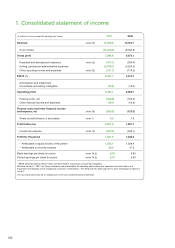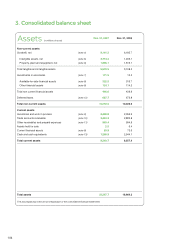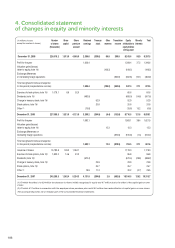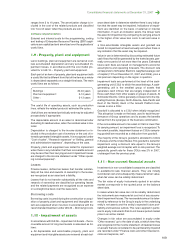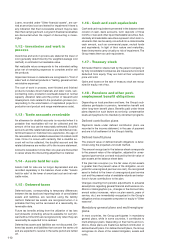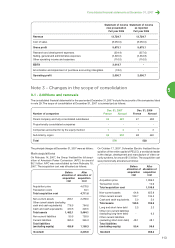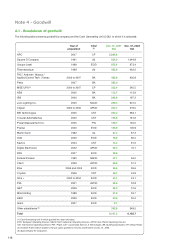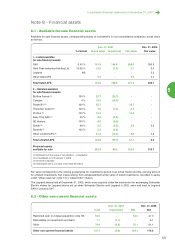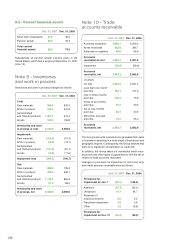APC 2007 Annual Report Download - page 114
Download and view the complete annual report
Please find page 114 of the 2007 APC annual report below. You can navigate through the pages in the report by either clicking on the pages listed below, or by using the keyword search tool below to find specific information within the annual report.In addition, certain long-term receivables and loans to sub-
sidiaries are considered to be part of the Group’s net in-
vestment, as defined by IAS 21 –
The Effects of Changes
in Foreign Exchange Rates
. In accordance with the rules
governing net investment hedging, the impact of exchange
rate fluctuations is recorded in equity and recognized in the
statement of income when the investment is sold.
Interest rate swaps
Interest rate swaps, which synthetically adjust interest
rates on certain indebtedness, involve the exchange of
fixed and floating-rate interest payments. The differential to
be paid (or received) is accrued (or deferred) as an ad-
justment to interest income or expense over the life of the
agreement. The Group does not apply hedge accounting
as described in IAS 39 for interest rate swaps. The impact
is immediately recognized in the income statement.
Commodity contracts
The Group also purchases commodity derivatives includ-
ing forwards, swaps and options to hedge price risks on all
or part of its forecast future purchases. Under IAS 39,
these qualify as cash flow hedges. The hedging instru-
ments are recognized in the balance sheet and are meas-
ured at fair value at the period-end. The portion of the gain
or loss on the hedging instrument that is determined to be
an effective hedge is accumulated in equity, under "Other
reserves", and reclassified into the income statement
under "Cost of sales" when the hedged transaction affects
profit or loss, leading to an adjustment of gross profit. The
ineffective portion of the gain or loss on the hedging in-
strument is recognized in "Other financial income and ex-
pense".
Cash flows from derivative financial instruments are rec-
ognized in the statement of cash flows in a manner con-
sistent with the underlying transactions.
Put options granted to minority shareholders
Under IAS 32 –
Financial Instruments: Disclosure and
Presentation
– commitments to buy out minority share-
holders (e.g. put options) must be recognized as a liability,
in an amount corresponding to the exercise price of the put
options.
In the absence of established accounting practice, the dif-
ference between the put options’ exercise price and the
share in the underlying net assets is posted to goodwill
without remeasuring the acquired assets and liabilities at
fair value. Subsequent changes in the fair value of the lia-
bility are recognized by adjusting goodwill.
1.23 - Revenue recognition
The Group’s revenues primarily include merchandise sales
and revenues from service and project contracts.
Merchandise sales
Revenue from sales is recognized when the product is
shipped and title transferred (standard shipping terms are
FOB).
Discounts offered to distributors are accrued when the
products are sold to the distributor and recognized as a de-
duction from revenue.
Certain subsidiaries also offer cash discounts to distribu-
tors. These discounts are deducted from sales.
Total revenue is presented net of these discounts and re-
bates.
Service contracts
Revenue from service contracts is recorded over the con-
tractual period of service. It is recognized when the result
of the transaction can be reliably determined, by the per-
centage of completion method.
Long-term contracts
Income from long-term contracts is recognized using the
percentage-of-completion method, based either on the
percentage of costs incurred in relation to total estimated
costs of the entire contract, or on the contract’s technical
milestones, notably proof of installation or delivery of
equipment. When a contract includes performance clauses
in the Group’s favor, the related revenue is recognized at
each project milestone and a provision is set aside if tar-
gets are not met.
Losses at completion for a given contract are provided for
in full as soon as they become probable. The cost of work-
in-process includes direct and indirect costs relating to the
contracts.
1.24 - Earnings per share
Earnings per share is calculated in accordance with IAS 33
–
Earnings Per Share
.
Diluted earnings per share is calculated by adjusting profit
and the weighted average number of shares outstanding
for the dilutive effect of the exercise of stock options out-
standing at the balance sheet date. The dilutive effect of
stock options is determined by applying the "treasury
stock" method, which consists of taking into account the
number of shares that could be purchased, based on the
average share price for the year, using the proceeds from
the exercise of the rights attached to the options.
1.25 - Statement of cash flows
The consolidated statement of cash flows has been pre-
pared using the "indirect method", which consists of rec-
onciling net profit to net cash provided by operations. Net
cash and cash equivalents represent cash and cash equiv-
alents as presented in the balance sheet (note 1.16) net of
bank overdrafts.
Note 2 - Change in
presentation
The Group has decided to use a new indicator to measure
performance: EBITA (Earnings Before Interests Taxes and
Amortization of purchase accounting intangibles) that fac-
tors out the impact of intangible assets recognized in a
business combination in accordance with IFRS 3.
It has therefore aligned the financial terms in external com-
munication with those used to track operating performance
internally.
EBITA corresponds to operating profit before amortization
and impairment of acquisition-related intangible assets and
before goodwill impairment. The intangible assets in ques-
tion are generally valued by outside experts and primarily
comprise trademarks, patents, technologies, customer lists
and distribution networks, which are amortized on a
straight-line basis over their useful life and tested for im-
pairment in accordance with IAS 36. Acquired trademarks
generally have an indefinite life and are not amortized.
To allow meaningful comparison, the presentation of data
for 2006 has been modified as follows:
112


